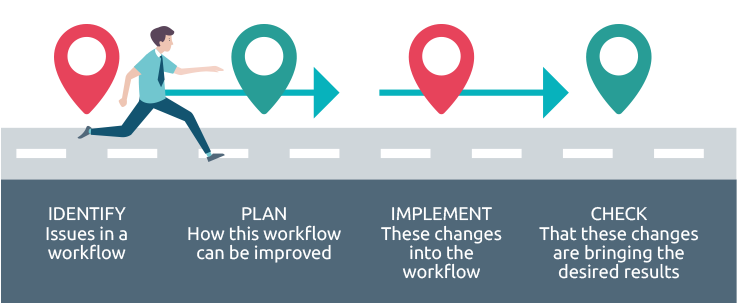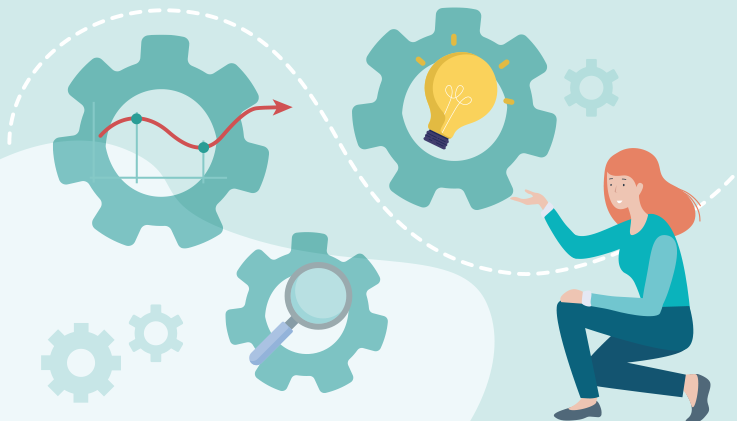In a time of continuously changing business conditions, organizations are under intense pressure to confront internal processes and ways of working that are not delivering expected results. Not just internal processes but external interactions with clients, partners, and supply chains are under the scanner as well. The focus is on optimizing the output of all business processes and agent activity.
Whether at an organizational or personal level, how we work is being restructured and rebalanced. The traditional top-down approach to management and work is not yielding results anymore, and there are many disadvantages to this approach.
A few disadvantages of top-down management and workflow are:
- Poor leadership impact
- Less room for creativity
- Team disengagement
- Less proximity to decision makers
Digitalization paved the way for a revolution in the workplace. People don’t just work anymore — they collaborate. There are healthy exchanges of ideas and knowledge. Existing workflow designs are becoming irrelevant due to the advancement of technology. Integrating technology is imperative for all industries.
The revolution in tech has forced decision-makers across industries to return to the drawing board. How will they design workflows that delight agents and customers alike? Let’s find out.
Why designing workflows is important
Reacting to a disruptive environment, process designs for internal operations and external interactions are being reconstructed, with new integrations between technology and humans.
The marriage between workflow design, sustainability, and resilience in business operations has three major characteristics: visibility, adaptability, and accountability.
A well-designed workflow can track customers and their interactions, as well as their touchpoints with the organization, as the main focus area rather than individual components of a docket or tickets like an order, an invoice, a request, or any unit of work.
This can be viewed as planning and mapping the customer journey, which opens up an entirely new field of insights. Additionally, by combining external customer insights with internal operational insights, designing process workflows helps connect your customers’ signals to leading operational indicators. This helps organizations identify the operations and processes that can affect the experience for a specific customer-offering segment.
Beyond basic discovery, workflow design reviews can help you audit whether actual operations conform to defined operations. Most organizations have internally defined standard operating procedures, policies, service level agreements (SLAs), work instructions, or best practices, which are sometimes embedded into enterprise applications such as helpdesk software, ERP, and CDP.
In practice, many of these predefined operations are complemented by automated operations. Workflow design helps validate or audit whether actual operations conform to these defined operations.
Also read: From Automation To Hyper Automation — The Helpdesk Revolution Is Underway
Simple rules to remember when designing workflows
The purpose of designing workflows is to view, operate, manage, analyze, and improve your business in dramatic ways. Creating workflows helps during work allocation. It ensures people are assigned tasks that are at par with their skill sets, training, and capabilities. One must keep in mind that the purpose of designing workflows is getting more insights into any business process. It helps keep work/activities organized and trackable.
The four phases of a successfully designed workflow are identification, planning, implementation, and review. First, you identify issues in a workflow. Secondly, you deliberate how the workflow can be improved. The third step involves changing the existing workflow to make the overall process more efficient. The final stage is about verifying that the changes made so far in your business processes or workflows are delivering the desired outcome.
When designing workflows, it is imperative every team member has to know their role in the process. Workflows, flowcharts, or process mapping, whatever one may choose to call the process, the final objective is the same. Improving communication and enabling delivery of customized solutions to client problems by identifying problem areas and potential roadblocks.
Sometimes the most well designed process can get complicated, and you are expected to prompt tasks or pose follow-up questions. In customer service, your process may face bottlenecks when you have to send confirmation to the customers and schedule when to give them a status update. What does one do when faced with such complications in their business or service delivery processes? Switch to automated workflows, of course.
ThinkOwl helps you create automated workflows
Automated workflows help you and your team deliver exceptional support faster. With intelligent workflows, you can individually manage processes and responsibilities in customer service without the hassle of programming any process separately. You only have to define the tasks and rules for the service processes yourself. If you are wondering how you will do that, we have the answer.
Business Process Model and Notation (BPMN) is a graphical notation that is widely used to model the internal business processes and workflows of organizations. BPMN is a global standard for process modeling. BPMN is designed to represent business processes in a standardized and consistent way, using various graphical elements such as tasks, events, gateways, flows, etc. ThinkOwl makes it super easy to design workflows yourself. It can help automate processes with active agent participation.
Using BPMN in your helpdesk provides the following benefits:
- Standardized processes
- User-friendly workflows
- Improved efficiency
- Better customer satisfaction

Importance of workflow design in customer service
The future of customer service is being connected to your customers. People do not look for multiple solutions to their problems. Instead, modern customers look for singular intelligent solutions that can tackle a wide array of issues.
Benefits of workflow design:
- Reduce costs
- Time savings
- Enhance efficiency
- Quality improvement
How to design meaningful workflows
Designing meaningful workflows impacts both agents and clients positively. Here’s how.
We shall look at how these four stages help improve the consumer experience.
Customers and prospects usually have questions or complaints about a myriad of issues like a wrong plan, lack of overview, confusing invoices, etc.,
To provide matchless customer service, every organization ought to follow these four processes:
(1) Capture customer information in a meaningful way
Capturing customer information can be stressful for both service agents and clients alike. On the one hand, clients get vexed by having to repeatedly provide or repeat their personal details to the service team. On the other hand, agents feel demotivated to collect or ask the client for their personal details for fear of being rebuked or yelled at. Having a process for collecting customer data can prevent multiple issues.
(2) Archive important data intelligently so that it is readily available when necessary
What is the point of data if it cannot be utilized when required? To prevent customer dissatisfaction due to data unavailability, it is important to have processes that archive customer data and process knowledge intelligently so that the knowledge is readily available when necessary. Care should be taken to ensure data and self-help content are recognized and stored in a manner that makes them easily retrievable.
(3) Contextual interaction with customers depending upon the severity of their issue
Offering your clients a “service that fits everyone” is a bad idea for your business. No two human beings are the same, and customers do not look for identical services from brands. Not all customers want their issues resolved by agents. Some may prefer to use
self-service systems, while others may opt to contact service representatives. Depending upon the nature of the client’s issue, having a set of service procedures/guidelines can help increase customer satisfaction and loyalty.
(4) Provide service without any breaks
In a world connected by technology, it reflects badly on the business if customers have to wait for answers to their questions and problems. Today it is imperative for businesses to provide service to consumers without any breaks. Digitalization has helped brands stay ahead of the curve, and now everything depends on how service is delivered. Workflow design or creating a blueprint for service delivery can help decrease costs for service and communication as well as optimize the overall process.
Also read: ThinkOwl CX Playbook – Your Ultimate Guide to Customer Success (eBook)
How to create a business continuity plan
There’s much talk about the need to be customer-centric in order to win and retain today’s connected customers. However, that’s easier said than done at scale, in real time, and across multiple channels. Irrespective of the timezone your business is located in, customers expect you to recognize their individuality, understand their often non-linear journeys, predict their unique needs, and deliver a truly engaging experience every time.
Leveraging technology and AI can help your service teams deliver human-centered CX in a tech-powered world. Virtual assistants, AI-powered chatbots, and live agent support via text and messenger platforms are tools that aid customers through their journey and impact CX.
Today, we are in the age of ‘predictive multichannel customer service’, where technology is used to predict customer needs and deliver personalized experiences wherever possible. Irrespective of whether human agents are available or not. Virtual customer assistants or conversation bots that fill in for live agents and intelligently guide customers toward case resolution.
Conversation bot has the potential to augment your organization's capabilities. You can use conversational bots to address soaring ticket volumes, address customer inquiries, and help your teams work remotely.
Conversation bot is a must in service delivery workflows
Conversation bots serve as excellent channels for customer engagement but also significantly reduce your contact center’s call volumes. You can ensure the fastest customer response times and improve agent satisfaction through the highest possible automation, thus ensuring an intuitive operability of your business process. To achieve this feat, conversation bots make use of AI and deep learning to determine user intent and resolve customer queries efficiently.
Conversational AI on multiple contact channels
Your customers want a seamless, frictionless digital experience throughout their journey with you. Being in sync with your customers' favorite communication channels implies being available on the phone, email, social media, live chat, web, and messaging platforms. To be able to transform your client's wishes into reality, you will need to analyze your workflows from scratch. Creating workflows that include conversation bots or virtual assistants will give your clients the confidence of knowing you are there for them, just a click away — even when love agents are not readily available to support them.
Hyperautomation simplifies customer service
Hyperautomation can help organizations scale their operations rapidly by automating processes that would otherwise require additional staff to handle. Besides making your enterprise more agile, it reduces your organization’s operating costs by automating redundant activities across multiple departments. Research by Gartner estimates that within the next four years, hyperautomation will reduce companies’ operating costs by 30 percent.
That’s not all; automation in helpdesk systems actually helps reduce customers’ overt dependency on live agents for everything. Even minuscule issues, like finding answers to frequently asked questions.
Pay attention to details, ramp up service quality, and deliver an exceptional customer experience. A cloud-based helpdesk software like ThinkOwl helps you manage multiple communication channels or touchpoints and enables you to take care of your customer requests round-the-clock – even remotely. Sign up now for a 30-day free trial.
